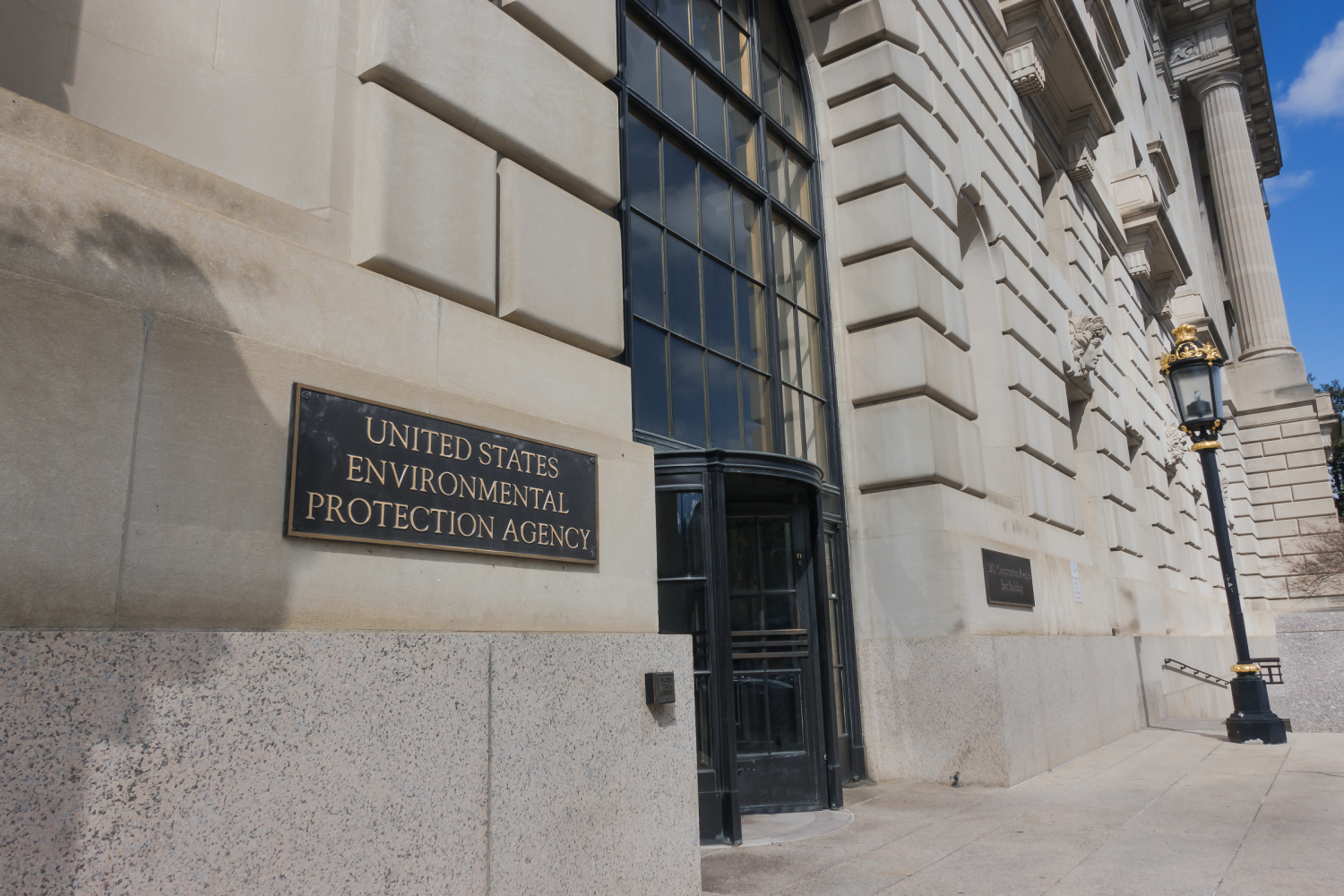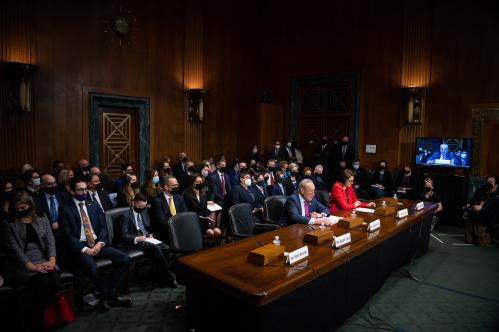Contractors are a mainstay of the federal government. While private sector contractors played critical and highly visible support roles for the Department of Defense and the Department of State in Iraq and Afghanistan, they also play quieter but still important roles assisting the Department of Education collect student loan repayments, the U.S. Agency for International Development run development programs, the Department of Energy manage its national labs, and the Environmental Protection Agency clean up hazardous waste sites, among numerous other tasks. In fiscal year (FY) 2020 alone, the U.S. government spent about $400 billion on service contracts, and by one estimate, there are roughly three contract employees for every one civil servant employed by the federal government.
Contractors also play an important but largely unexamined role in helping agencies write rules. There are two reasons why it is important to understand what is happening here. First, rules are legally significant, so anything—or anyone—that influences them has impact. Once agencies follow the cumbersome notice-and-comment process the resulting rules carry the same force and effect as laws passed by Congress. Second, rules are politically significant. Rulemaking was central to former President Trump’s political agenda, and it continues its prominent role in President Biden’s administration.
In this report, I examine how contractors contribute to the rulemaking process at federal agencies. The short version of the story is that contractors actively contribute to rulemaking, but there is little understanding of what this means in practice. Put simply, we do not know a lot about which tasks contractors perform for which rules and which agencies. To unpack this, I draw on a narrow slice of procurement data and provide a snapshot of contractor activity in rulemaking, exploring which agencies are most actively engaged in regulatory service contracting and the amounts they have allocated for these activities in recent years. I also look at the firms that provide these services, with an eye toward understanding the types of contractors that do this work and where they are located. Finally, I explain why the reach of these data is so limited and argue that scholars and policymakers should give greater attention to contractors in rulemaking.
Are contractors really involved in rulemaking?
The question of who writes the nation’s laws is a question of critical importance, both substantively and in terms of democratic legitimacy. Therefore, it may come as a surprise to some that contractors are involved in rulemaking at all. Under the “inherently government function” (IGF) standard, government officials are required to make policy decisions on behalf of the federal government. This applies to rulemaking and the policy direction adopted by a rule. However, rulemaking support is considered “closely associated” with IGF, meaning that agencies can use contractors to help with many aspects of producing a new rule—although there are questions about what this legal standard means in practice.1
To be sure, contractors can be a valuable asset to agencies in writing rules. The private sector is often nimbler and more flexible than the federal government; this means that looping in contractors can help agencies to write rules more quickly and efficiently. Additionally, contractors can provide a well of expertise that agencies can tap on an as-needed basis. Reasons like this have propelled presidents from Reagan onward to pursue contracting out as a means of administering services across the federal government.
But there is not a lot of transparency to what contractors do in rulemaking; agencies are not required to disclose what rulemaking work is done by contractors rather than federal employees. The result is that the work contractors perform in rulemaking is often difficult to observe from the outside. So, for example, while a contractor might play an integral role in preparing an agency’s cost benefit analysis (CBA)—a document that could span hundreds of pages—there is no standardized way that an agency is required to report this to the public.
Yet, traces of contractor contributions to rulemaking abound. Recent government reports make reference to contractors supporting agencies in processing public comments, particularly for rules that receive large numbers of comments. Additionally, numerous contracting firms advertise the assistance they are able to provide government partners on a panoply of rulemaking services, including regulatory drafting support, Federal Register document publication, assistance in conducting regulatory impact analysis and other analyses, and general project management support. Presumably, these firms have customers!
It is difficult to move beyond anecdotes to systematically discern how contractors are shaping agency rules. The federal appropriations process offers limited insight. Although Congress appropriates monies to agencies that are eventually allocated into rulemaking projects and contract dollars, appropriations are rarely, if ever, made at the rule or the contract level. This makes it nearly impossible to track forward from appropriated dollars to rulemaking contracts.
The federal procurement system offers a better window into contracting for rulemaking. After making contract awards, agencies report their contract spending to a centralized database, the Federal Procurement Data System-Next Generation (FPDS for short) and publish the products or services that were obtained via contract. This accounting is admittedly imperfect; the FPDS was designed for procurement oversight and not to tie contracts to specific projects. Nevertheless, at present the FPDS offers one of the only systematic ways to understand the role of contractors in rulemaking.
What do we know about rulemaking contracts?
To develop insight into the role of contractors in rulemaking, I gathered federal procurement data from FY 2001 to FY 2021. I collected these data from the website www.usaspending.gov, which relies on the FPDS.2 These data follow a standardized coding schematic with two particular codes that relate directly to rulemaking: regulatory studies and analysis and cost benefit studies and analysis. The figure below shows that contract spending for these two services over the period from FY 2001 to 2021. In an average year, federal agencies spent $26 million on contracts for regulatory analysis services and $13 million on contracts for cost benefit services. Notably, however, contract spending in these areas has increased over time, particularly for regulatory analysis services. In the peak year, 2017, the federal government spent $64 million on these services.

Contracting for services related to rulemaking is not spread evenly across government. Some agencies are much more likely to contract for these services. As shown in the table below, the Environmental Protection Agency (EPA) is by far the biggest spender in in this area, followed by the Department of Health and Human Services (HHS) and the Department of Defense (DOD). In terms of procurement spending, however, these contracts are a drop in the bucket for these agencies; for instance, rulemaking-related contracts accounted for just 1.8% of EPA’s contract spending in FY 2020 and less than 0.1% of HHS’s spending.
These patterns loosely track regulatory output. The third column of the table shows counts of significant final rules, or rules with a substantive impact, published by each agency during FY 2020, and the fourth column shows the number of economically significant final rules.3 This latter type of rule requires agencies to perform more rigorous analyses of costs and benefits, making contractor support potentially attractive should agencies need additional technical expertise or help with the associated increase in workload. Across these two sets of rules, the EPA and HHS—the two highest spenders in FY 2020—ranked highly. Meanwhile, DOD, which ranks third on the list, issued relatively few rules. And the Department of Homeland Security (DHS) and Department of Transportation (DOT) issued comparable numbers of significant and economically significant rules, despite the former spending more than 14 times as much on contracts for the designated services than the latter.
Top Agencies by Spending on Regulatory Contractors
| Agency Name |
Total Spending (FY 01-21) (in millions) |
FY 20 Spending (in millions) | FY 20 Significant Final Rules | FY 20 Economically Significant Final Rules |
| Environmental Protection Agency | $380.5 | $20.4 | 20 | 5 |
| Department of Health and Human Services | $92.4 | $19.6 | 34 | 23 |
| Department of Defense | $121.5 | $5.74 | 6 | 1 |
| Department of Homeland Security | $73.6 | $5.7 | 12 | 5 |
| Department of Transportation | $54.9 | $0.4 | 13 | 2 |
Other factors provide additional context for these patterns. For example, the EPA—the largest spender for these two services— has long faced staffing shortages, suggesting that contractors may fulfill a critical role keeping the agency’s rulemaking pipeline flowing. Additionally, the DOD spends more on service contracting than all other civilian agencies combined. So, while DOD issued many fewer regulations than the other agencies in the table, broader agency patterns about workflow and personnel management may partially explain what is going there.
Overall, these data show a relatively small market of firms that provide rulemaking-related services. Only about 380 contractors perform these services, and nearly half (48%) of them are located in Virginia. Small businesses held nearly half of contracts (46%), but as the table below indicates there are also larger firms that operate in this space.
Largest Rulemaking-Related Contractors, FY 2001-2021
| Rank | Firm Name | Total $ Awarded (in millions) |
| 1 | Tetra Tech | $152.0 |
| 2 | Research Triangle Institute | $45.9 |
| 3 | Abt Associates Inc. | $41.1 |
| 4 | ICF International | $38.2 |
| 5 | Executive Management Associates | $36.1 |
| 6 | Tecolote Research | $34.9 |
| 7 | General Dynamics | $29.8 |
| 8 | Eastern Research Group | $23.6 |
| 9 | PricewaterhouseCoopers | $22.5 |
| 10 | Plexus Scientific Corporation | $18.2 |
Some of the firms in the table are familiar; General Dynamics is a Fortune 500 aerospace and defense company, and PricewaterhouseCoopers is a multinational professional service consultancy. Many of the other firms are boutique scientific, technical, and policy consultancies and research firms. While not household names, these companies range in size; ICF International is a $1.5 billion firm with 7,000 employees, while Eastern Research Group is a $50 million company with 325 employees. Among these firms, most perform rulemaking-related services for one agency. For example, 99% of Tetra Tech’s (#1) contract funds for these services came from the EPA, and 92% of Tecolote’s (#6) contract funds came from the DOD.
What exactly do these companies do in terms of helping agencies with their rulemakings? Without further information it’s hard to say more precisely. For example, Tetra Tech provided $152 million in regulatory analysis services to the EPA, but the associated contract award descriptions that are publicly available are not very revealing, indicating only that the firm offered “technical and administrative support” for the Office of Wastewater Management.
This all might seem like splitting hairs. The EPA has a $9 billion budget and Tetra Tech is a $3 billion firm, and therefore it may seem that these relatively small contracts are not noteworthy. But this relatively small scale and the fact that few are paying attention to contracts for rulemaking, per se, inevitably invites questions about potential conflicts of interest. For example, Tetra Tech advertises its regulatory compliance services, helping private sector clients comply with EPA water regulations. These types of situations raise the possibility that the same company could be helping the government produce regulations and helping regulated parties comply with them. How can agencies assuage such ethical concerns?
Does regulatory contracting out matter?
This report provides some of the first systematic evidence on regulatory contracting. But because the dollar amounts presented above are little more than a rounding error in the context of overall federal spending on service contracts, one might be inclined dismiss regulatory contracting as unimportant or inconsequential. That would be a mistake for at least two reasons.
First, the portrait that I have presented above is—admittedly and frustratingly—incomplete. It examines contracts that are marked as being associated with rulemaking in a broad sense—either as a “regulatory analysis” or by virtue of providing a cost benefit study. Yet, agencies might reasonably classify regulatory contract spending under more generic headings (e.g., within the broader category of “program management and support”).4 Second, some agencies have moved toward bundling services into larger contracts. Doing so cuts down on costs associated with managing many smaller contracts. However, bundled contracts can obscure the “what” of a service contract and make it hard to know whether a contractor is working on a rule or something else entirely. These trends mean that we are only able to view one narrow portion of contract spending that is explicitly allocated toward rulemaking services. It is quite likely that much more is happening than what we can observe here. Put simply, the data presented here are, in all likelihood, the tip of the iceberg.
Second, observers and scholars have raised several concerns about contracting out for government services more broadly that may hold in the rulemaking context as well. For example, some scholars argue that contracting out is associated with diminished transparency since contractors are not bound by the same restrictions as government, such as judicial review, freedom of information and disclosure laws, and sundry laws designed to promote participation and rationality in decision-making. How does this diminished transparency affect the rulemaking process, where transparency is arguably a core value?
Conclusion
The title of this report asks, “How much of rulemaking is done by contractors?” The answer, in brief, is that there is clearly a meaningful amount, but we just do not have enough information to know the full scope of the practice. As a consequence, this report should be understood as a first cut at an important question.
To develop a more holistic response to these questions, my colleague Bridget Dooling and I are exploring these questions in a project commissioned by the Administrative Conference of the United States. We hope to develop answers to questions such as: In what ways do academic concerns about contracting out apply to rulemaking? Why do agencies turn to contractors to help in rulemaking? What kinds of rulemaking tasks do contractors perform? You can track our progress on this site.
The author did not receive financial support from any firm or person for this article or from any firm or person with a financial or political interest in this article. The author is not currently an officer, director, or board member of any organization with a financial or political interest in this article. The views in this post are those of the author alone and do not represent the views of the Administrative Conference of the United States (ACUS) or the University of Virginia. The author is serving as a consultant to ACUS, but did not receive financial support from ACUS for this post.
-
Footnotes
- With respect to rulemaking, a 2011 policy letter from the Office of Management and Budget indicates that contractors can be employed in “support for policy development, such as drafting policy documents and regulations, performing analyses, feasibility studies, and strategy options,” but not for the “the determination of the content and application of policies and regulations.” Although this may appear cut and dry, in practice the line between something like “drafting” a regulation and “determining” policy content can be quite blurry indeed.
- To ascertain the substantive focus of each contract, I rely on the listed “Product and Service Code.” Agency contracting officers characterize each contract according to the category most appropriate for the “preponderance of work.” This analysis focuses on two specific codes; “Special Studies/Analysis- Regulatory” (B528) and “Special Studies/Analysis- Cost Benefit” (B505).
- Under Executive Order 12866, an “economically significant” rule is one that is expected to have an annual effect on the economy of $100 million or more and a rule designated as “significant” is one that meets the economic criterion or that “raises novel legal or policy issues,” among other factors. Data on significant and economically significant rules are drawn from searches of www.reginfo.gov of rules published by the respective agency during FY 2020.
- It is also possible that contracts for these two services might not even be associated with rulemaking at all. For example, agencies may conduct cost benefit analysis as an internal management tool, completely apart from rulemaking.
The Brookings Institution is committed to quality, independence, and impact.
We are supported by a diverse array of funders. In line with our values and policies, each Brookings publication represents the sole views of its author(s).







